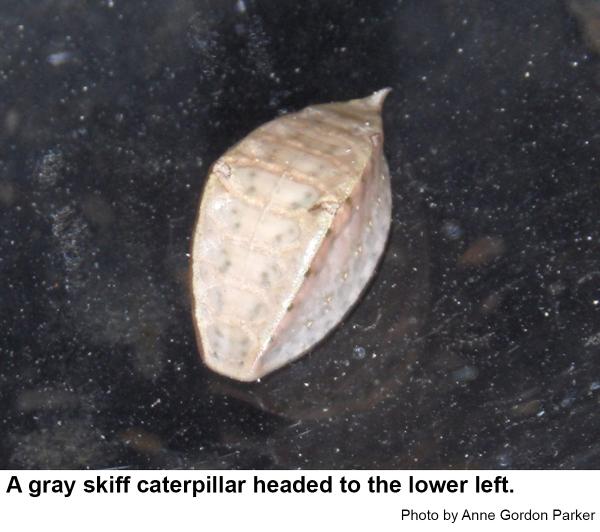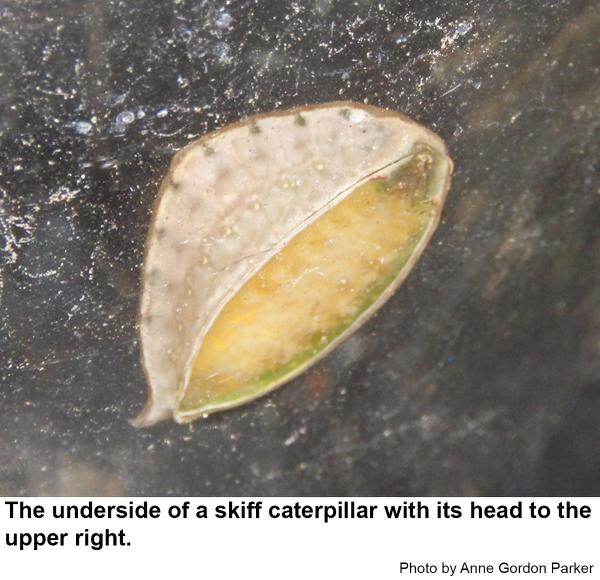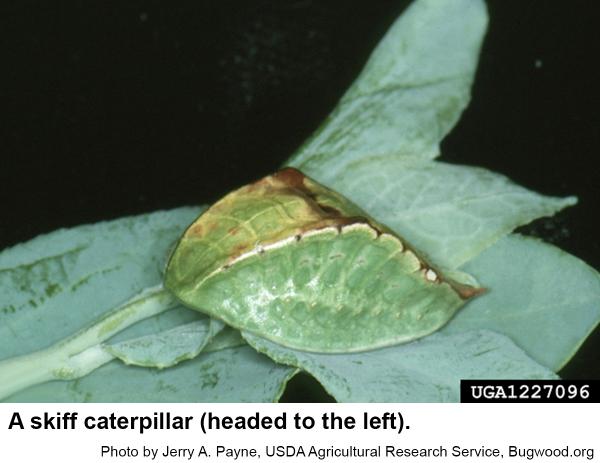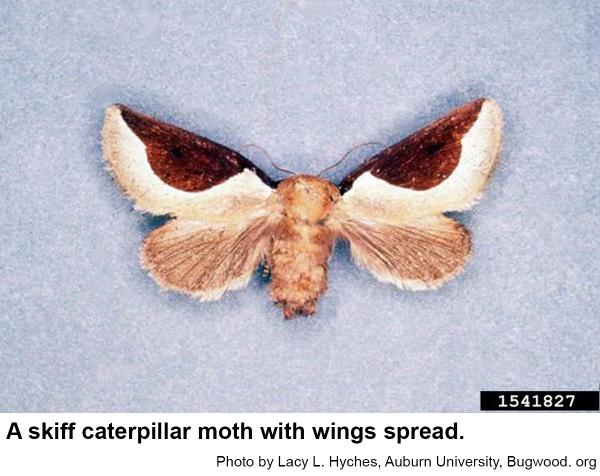Desription and Biology
The skiff caterpillar, Prolimacodes badia, is an unusual caterpillar in the family of slug caterpillars that includes the saddleback, hag moth, and puss caterpillar. The skiff caterpillar is humped and has two ridges running fore and aft ending in a short but pronounced 'tail.' Each ridge has a small, pointed bump at the crest. The head is retracted into the thorax, and the legs are not visible so that the caterpillar vaguely resembles a small, overturned boat (skiff). Sometimes skiff caterpillars are gray, whereas others may be green or green with small to large brown blotches. Although some of the other slug caterpillars have clusters of spine-like, urticating hairs that cause a painful sting, the skiff caterpillar does not and therefore probably cannot sting. Each caterpillar spins a tough, brown, oval silk cocoon in which the insect overwinters. The following growing season, the skiff caterpillar moth emerges, mates and lays flat eggs either in small groups or singly. Skiff caterpillar moths are gray to beige with dark brown markings on the outer edge of the wings. The thorax has a noticeable tuft of setae. The moths are about an inch (or a little more) long with the wings folded at rest.
Host Plants
Skiff caterpillars feed on American hophornbeam, beech, black cherry, bog-myrtle, maple, oak, sycamore, and other trees and shrubs.
Residential Recommendations
This family of caterpillars is often parasitized by tiny brachonid wasps that, along with bacterial and viral diseases, usually keep the population sparse. No control recommendation seems necessary as the skiff caterpillar is hardly ever abundant. It is more of a curiosity than a true plant pest. In case of an outbreak of skiff caterpillars, Sevin or some other insecticide labeled for landscape use should give more than adequate control.
References
- Eastern Forest Insects. Baker, W. L. 1972. USDA Forest Service Misc. Pub. 1175. 647 pp.
- Insects of Eastern forests. Drooz, A. T. editor. 1985. USDA Forest Service Misc. Publication 1426. 608 pp.
- Prolimacodes badia. Anonymous. 2018 (last ed). Wikipedia, the Free Encyclopedia.
- Species Prolimacodes badia - Skiff Moth – Hodges#4671. Bartlett, T. And R. McLeod. 2010 (update). BugGuide. Iowa State University.
- Extension Plant Pathology Publications and Factsheets
- Horticultural Science Publications
- North Carolina Agricultural Chemicals Manual
For assistance with a specific problem, contact your local Cooperative Extension Center.
This Factsheet has not been peer reviewed.
Publication date: April 12, 2016
Reviewed/Revised: Oct. 14, 2019
Recommendations for the use of agricultural chemicals are included in this publication as a convenience to the reader. The use of brand names and any mention or listing of commercial products or services in this publication does not imply endorsement by NC State University or N.C. A&T State University nor discrimination against similar products or services not mentioned. Individuals who use agricultural chemicals are responsible for ensuring that the intended use complies with current regulations and conforms to the product label. Be sure to obtain current information about usage regulations and examine a current product label before applying any chemical. For assistance, contact your local N.C. Cooperative Extension county center.
N.C. Cooperative Extension prohibits discrimination and harassment regardless of age, color, disability, family and marital status, gender identity, national origin, political beliefs, race, religion, sex (including pregnancy), sexual orientation and veteran status.






